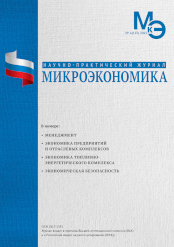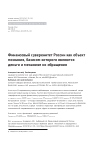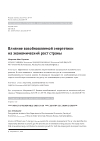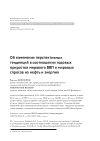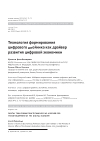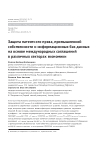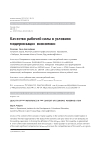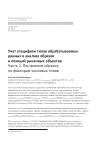Financial sovereignty of Russia as an object of knowledge, the basis of which is money and the mechanism of its circulation
DOI: 10.33917/mic-6.113.2023.95-104
In the modern conditions of globalization of economic and other relations, new challenges and threats are emerging in the world. Against this background, specific threats to the financial sovereignty of Russia have become widespread, due to the economic and legal properties of modern «paper» money and their separation from the objective material basis — from the equivalent commodity, which results in the absence of a standard measure of value. This problem is very acute in not only economics and finance, but also in law, in particular, in the field of criminal law when qualifying criminal acts of an economic orientation and other areas of economic and legal relations.
References:
1. The Constitution of the Russian Federation (adopted by popular vote on 12.12.1993 with amendments approved during the all-Russian vote on 07.01.2020). SPS «ConsultantPlus».
2. Federal Law «On the Central Bank of the Russian Federation (Bank of Russia)» dated 07.10.2002 No. 86-FZ, art.4, p.18.2. SPS «ConsultantPlus».
3. Federal Law No. 173-FZ dated 12/10/2003 (as amended on 11.04.2014) «On Currency Regulation and Currency Control» (with amendments. and an additional introduction. effective from 01.01.2015) / Collection of legislation of the Russian Federation, 15.12.2003, N 50, art. 4859.
4. Federal Law No. 390-FZ dated December 28, 2010 «On Security». SPS «ConsultantPlus».
5. Decree of the President of the Russian Federation dated 07.02.2021 No. 400 «On the National Security Strategy of the Russian Federation». URL: http://www.pravo.gov.ru
6. Decree of the President of the Russian Federation dated 05.13.2017 No. 208 «On the Strategy of Economic security of the Russian Federation for the period up to 2030» // Official Internet portal of legal information. URL: http://www.pravo.gov.ru; NW RF. 2016. No. 1 (Part II). / http://pravo.gov.ru
7. Articles of Agreement / International Monetary Fund. URL: http://www.imf.org/external/pubs/ft/aa/rus/index.pdf
8. Anishchenko V.N., Khabibulin A.G., Anishchenko E.V. Investigation of economic crimes. Theoretical and methodological foundations of economic and legal analysis of financial activity: Book. M.: YURAIT, 2018. (In Russ.).
9. Anishchenko E.V. Security of Russia in the context of socio-economic reforms // Financial analytics (scientific, practical and information-analytical collection). 2014, April, No.14(200). (In Russ.).
10. Anishchenko A.V. Russia in the system of global risks // Bulletin of the Academy of Economic Security of the Ministry of Internal Affairs of Russia. 2011;6:103-105. (In Russ.).
11. Molchanov A.V. Anishchenko V.N. et al. Financial security of the country: problems and prospects // Economic security of the financial system: Collection of scientific papers. / Ed. Honored Economist of Russia, Doctor of Economics, Professor A.V. Molchanov. M.: AEB of the Ministry of Internal Affairs of Russia, 2007.
12. Rose K.B. Mechanisms and limits of US influence in the IMF: Analytical review (Series: Socio-economic problems of Western countries). Moscow: INION RAS. The Center of scientific information. research. global. and regional. problems. Otd. Zap. Europe and America. Ed. Semeko G.V., 2013. 98 p. ISBN 978-5-248-00703-5 / https://cyberleninka.ru/


